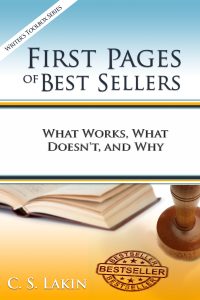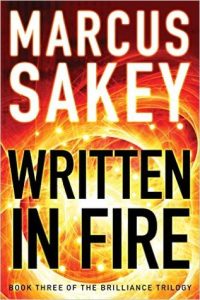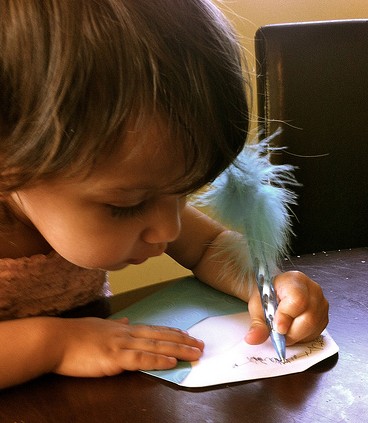The 2 Key Elements That Make a Great Scene
Writing great scenes takes a lot of practice and know-how. There are so many elements that must work beautifully, perhaps magically, to draw in readers and get them hooked.
It’s crucial you deeply understand the exact genre you are writing in because those readers who pick up your book have expectations. And you must meet those expectations, or you are going to disappoint them.
It’s as simple as that.
Look Carefully at First Scenes
I’ve written thousands of words in my books and blog posts about first scenes. In fact, I have an entire book devoted to just first pages of best sellers—analyzing, tearing them apart, to show you what works and what doesn’t.
You should be doing this same type of homework, whether you write fiction or nonfiction. There is a target audience for your book, possibly hundreds of thousands of readers—readers who would love your book.
 But you aren’t going to reach them or please them unless you first identify what they look for in a book like yours.
But you aren’t going to reach them or please them unless you first identify what they look for in a book like yours.
It really isn’t rocket science.
If you write YA romance, you grab a dozen or more best sellers in that genre and you study hard how those scenes are written. It’s not just about coming up with a great plot and appropriate character types and call it good.
You have to look at voice, word choice, length of sentences, length of chapters, amount and type of description, and the list goes on and on.
But the two most important “markers” you need to study are the writing style and the microtension.
Why?
Because it’s the writing style that captivates and screams “genre” to the reader. And it’s the microtension that grabs them and keeps them reading. Without mastering these two elements and nailing them, you may as well toss your book project into the little trash icon on your computer.
Microtension
Microtension is all about raising curiosity in your reader. Every word, phrase, and sentence that gives your reader pause and makes them curious equates to microtension.
Go through those best sellers and highlight those bits on each page that make you wonder what is going on, why that one word was used, what the author is implying, what might happen next.
How many words and phrases did you highlight? That tells you what you need to do on every page of your novel or short story.
If you can print out this blog post, do so, then try this exercise with the passage I share below from Marcus Sakey’s third book in his Brilliance series, Written in Fire.
Point of View
 Take a look at how Sakey creates strong curiosity by going deep into POV.
Take a look at how Sakey creates strong curiosity by going deep into POV.
If you haven’t noticed, most successful commercial novels of our time are told in deep POV. That means you are in the character’s head, in his voice, every word of every line. This is not the author telling and explaining what the story is about. This is all about showing moments in real time wholly through a character.
If you write fiction, and you haven’t mastered deep POV, you need to put your writing on Pause and study this technique. You will have a hard time seeing success with your novels if you don’t do this.
Writing Style
I want you to also take a look at the writing mechanics in this scene. The way you, the reader, are made to pause, pay attention to specific words. That’s done with the use of short (sometimes one-word) sentences. They are like strong punctuation marks.
Beautiful writing pulls in literary devices. You’ll note Sakey uses anaphora—repetition of a starting word in multiple lines of text. Using literary devices doesn’t mean you are writing highbrow or complex sentences hard to understand. But doing so can elevate your writing.
With this type of suspense/thriller genre, a writer needs to write tight. Every word counts. That should be the case no matter what you write. But some genres are wordy and flowery, and readers expect and want that.
Do I need to remind you? Do your genre homework, and copy what the best-selling, best-loved authors do.
As you read this partial scene, essentially a prologue, listen to the character’s voice, see what you learn about him quickly, and note those bits that create curiosity in you. What is odd, unusual, unexpected, surprising, incongruous?
After you read a great scene in your targeted genre, do this kind of analysis. Highlight the text in your Kindle, or mark up a paperback. I always buy paperbacks so I can do this type of homework in the pages, using different colors to highlight different things.
I learn a lot. You will too.
So … dig into Sakey’s scene and see what you notice:
Written in Fire
This must be what God feels.
A single glance at my outstretched hand and I know the number of hair follicles covering the back of it, can differentiate and quantify the darker androgenic strands from the barely discernible vellus hairs.
Vellus, from the Latin, meaning fleece.
I summon the page in Gray’s Anatomy on which I learned the word and examine the diagram of a hair follicle. But also: The texture and weave of the paper. The attenuation of light from the banker’s lamp that illuminates it. The sandalwood scent of the girl three chairs down. I can evoke these details with perfect clarity, this utterly forgettable and forgotten moment that nonetheless was imprinted in a cluster of brain cells in my hippocampus, as every other moment and experience of my life has been. At a whim I can activate those neurons and scrub forward or backward to relive the day with full sensual clarity.
An unimportant day at Harvard thirty-eight years ago.
To be precise, thirty-eight years, four months, fifteen hours, five minutes, and forty-two seconds ago. Forty-three. Forty-four.
I lower my hand, feeling the extension and contraction of each individual muscle.
The world rushes in.
Manhattan, the corner of 42nd and Lexington. Cars and construction noises and throngs of lemming-people and cold December air and a snatch of Bing Crosby singing “Silver Bells” from the opening door of a cafe? and the smells of exhaust and falafel and urine. An assault of sensation, unfiltered, overwhelming.
Like descending a staircase and forgetting the last step, empty air where solid floor was expected.
Like sitting in a chair, then noticing it’s the cockpit of a fighter jet going three times the speed of sound.
Like lifting an abandoned hat, only to discover it rests on a severed head.
Panic drenches my skin, panic envelops my body. My endocrine system dumps adrenaline, my pupils widen my sphincter tightens my fingers clench—
Control.
Balance.
Breath.
Mantra: You are Dr. Abraham Couzen. You are the first person in history to transcend the boundary between normal and abnormal. Your serum of non-coding RNA has radically altered your gene expression. A genius by any measure, you are now more.
You are brilliant.
People flow around me as I stand on the corner, and I can see the vector of each, can predict the moments they will cross and bump, the slowed step, the itched elbow, before they happen. I can, if I wish, screen everything down to lines of motion and force, an interactive map, like a fabric weaving itself.
The scene goes on for another page, and Couzen realizes he’s being watched. After examining the stimuli that tells him this fact, we read the last lines of the scene:
They are many, they are armed, and they are here for me.
I roll my neck and crack my fingers.
This should be interesting.
That’s the end of the scene.
Other Observations
I hope you noticed the clever way Sakey tells readers who this character is and what he’s done (a doctor who’s developed a serum that can make any “normal” into a “brilliant” or abnormal human, and he’s experimented on himself as his first human subject). He does this in POV. Not author interrupting and explaining to the reader. Having Couzen recite this mantra makes sense.
Whether you’ve read the two prior books or not, Sakey does a “brilliant” job of setting the stage, bringing in the title of his series (also his theme), creating tension (inner and outer) and introducing conflict (hinting at high stakes), showing emotion and body awareness (important!).
Look at the white space on the page. Did you see how alternating between long paragraphs and short, tight lines (even a word or two) keeps the reading fresh and interesting? If he had written all very long paragraphs, consider how that would have impacted your reading.
Try this with your own writing, especially if you tend to craft long paragraphs OR paragraphs that are almost all the same length. Think about those pauses and where you need to create them. Where do you want readers to slow down or speed up? This is done with writing style and mechanics.
I hope you will start doing this type of analysis with every book you read. Especially note what’s not working and what’s lacking in books that bore you.
For every “brilliant” book I look at (I pick up a lot of free novels on Amazon for my Kindle specifically to do this type of analysis), there are about fifty others that are boring, poorly written books. And these two elements are usually the dominant reasons for novel fail.
Two key elements: writing style and microtension. Don’t leave home write any scene without them!
Share in the comments your thoughts and reactions to this passage. What stands out to you as brilliant? What did you learn from this post and this examination?
Featured Photo by Soroush Karimi on Unsplash












Thank you SO much for this article! I am working on two stories, and will now be dissecting like crazy. Deep POV has always been an issue for me. I will have to try this internal conversation method with some of my characters. The tension he was able to create in that short space was phenomenal.